Thanks to Justis Millis for proofreading and feedback. The post is also available on surveyanon.wordpress.com.
I previously did a survey of gender identity in (mostly straight) men. The biggest albeit expected finding there was confirming that autogynephilia is a major factor in gender identity. A lesser but more surprising finding was that gender conservatism/progressivism is a significant factor in gender identity, perhaps representing what some call "repression" (gender conservative AGPs trying to get rid of their gender issues) or others call "social contagion" (pro-transgender politics spreading and causing transitions). Since doing this survey, I have confirmed in another sample I recruited on /r/AskAGP that gender conservatism is a major factor (and so the original finding is not just overfitting).
I got a $865 grant from Zack M. Davis in 2022 to study homosexual men with a similar methodology. The findings here are more confusing, but I thought it was about time I wrote them up so I can wrap up this project. Briefly, I recruited about 200 gay men on Prolific, asked the ones who wanted to be women to tell me about why, and factor-analyzed the results. I also introduced psychometric measurements from other works to test various hypotheses that popped up.
For those following along at home, the raw data is available here (and includes some additional surveys I didn't get around to analyzing in this post).
Gender Identity
To measure affective gender identity, I took some items from the previous study, primarily ones that had a high factor loading. This led to a battery of 7 items:
- If you had the opportunity to magically try being female, with the option of switching back, how long would you try?
- Body sex satisfaction (an item with detailed response options, see the prior study for screenshot)
- Do you think you could be happy if you were a woman?
- If you were to suddenly magically become a woman, how confusing would it feel?
- If you somehow magically became a woman in mind and body, would you still consider that to be "you"?
- How often do you daydream about being or becoming a woman?
- 0-10 gender identity rating (specifying 5 as a midpoint and "being a man/woman worse than death" as the endpoints)
Factor-analytically, the items were unidimensional, and I like making this sort of plot to visualize the meaning of the scores:
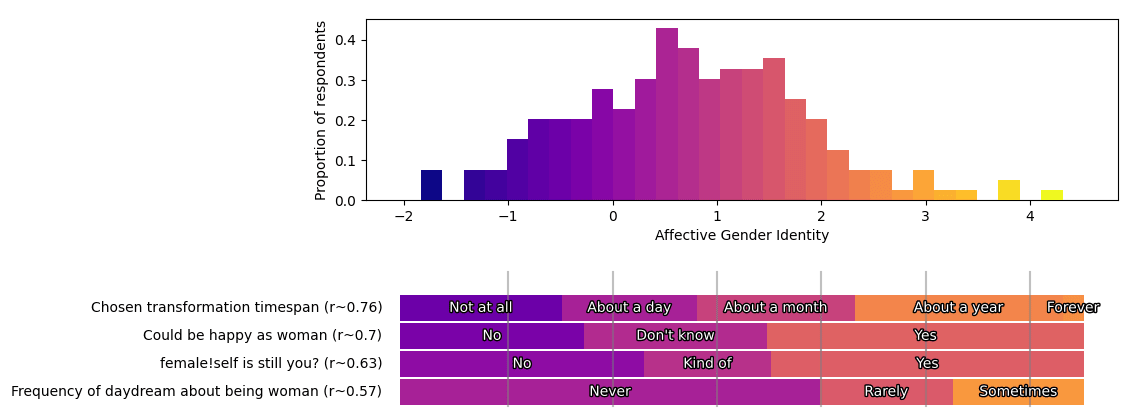
The rows underneath the chart correspond to a select set of items, and the boxes show the median response for a given range on the chart. So for instance, "about a month" is under the interval from 1 to 2, indicating that on average, men with a gender identity score of 1 to 2 would tend to pick "about a month" as the length of time they would be transformed into women.
Since gay men are in many ways more feminine than straight men, one might expect gay men to have more desire to be women than straight men do. However, this was not the case: this sample of gay men had essentially the same average scores on the gender identity items as the prior sample of straight men did.
Factor Analysis
According to the scree plot, there were 2 major factors, and perhaps 5 noteworthy factors.
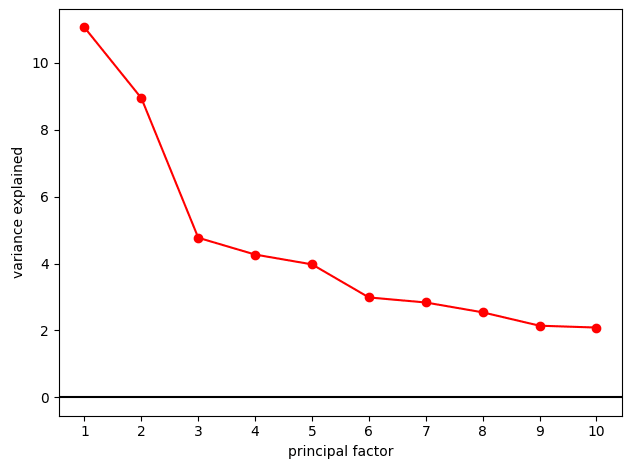
After examining the factor solutions, I settled on the 5-factor model. It had factors that I labelled Feminine Appearance, Extraversion, Homosociality, Gender Progressivism/Pride, and Neuroticism/Eccentricity/Sensitivity.
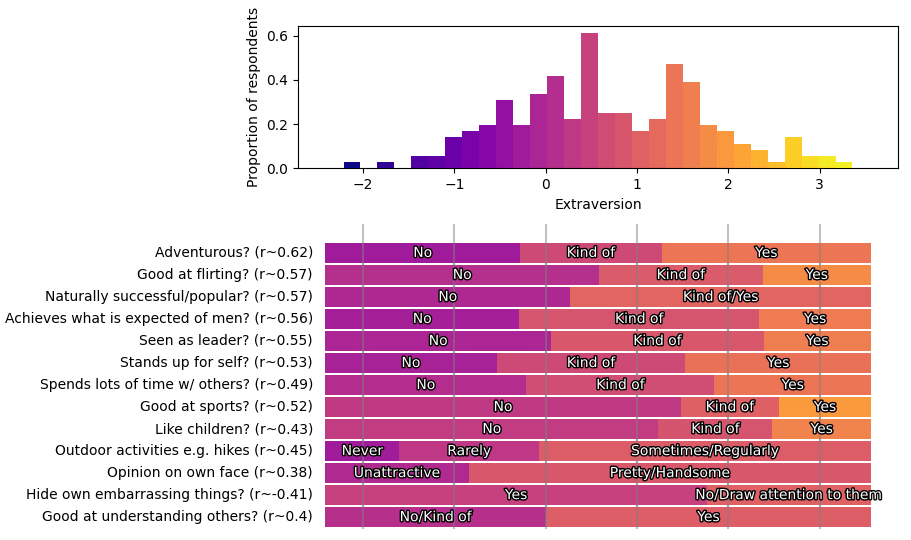
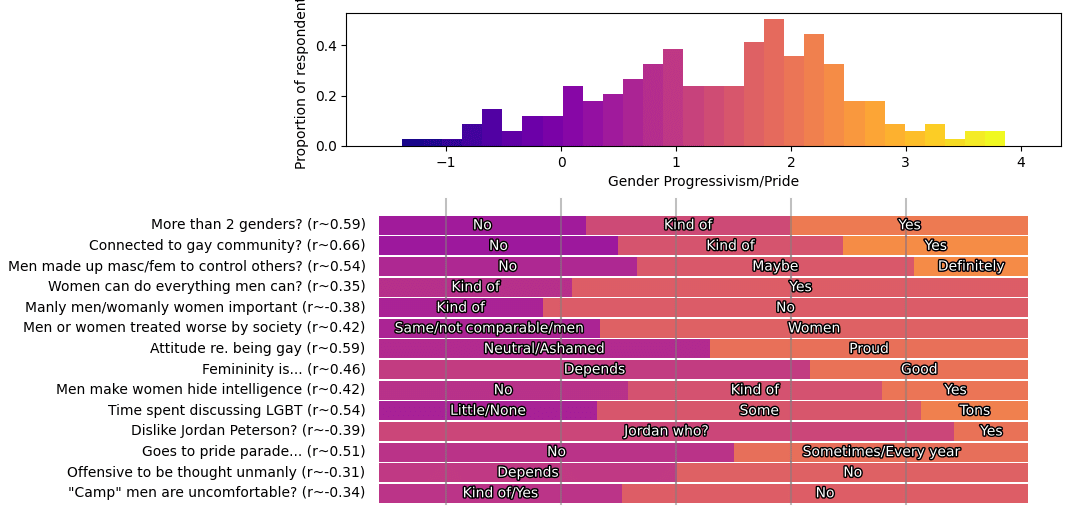
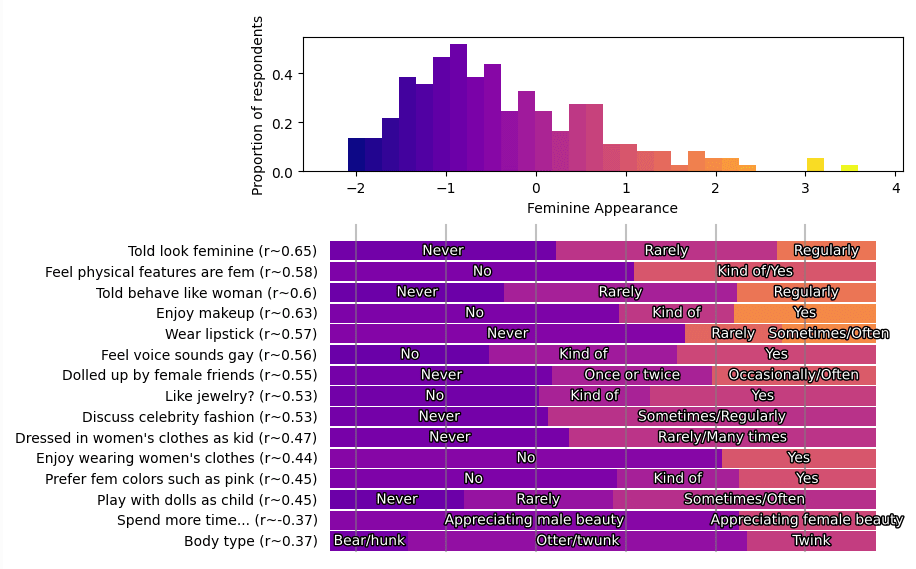
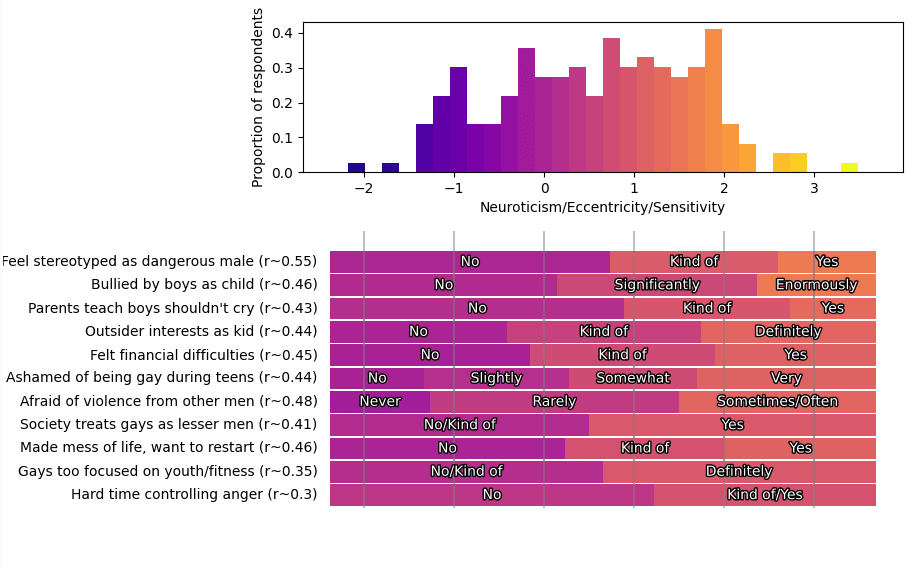
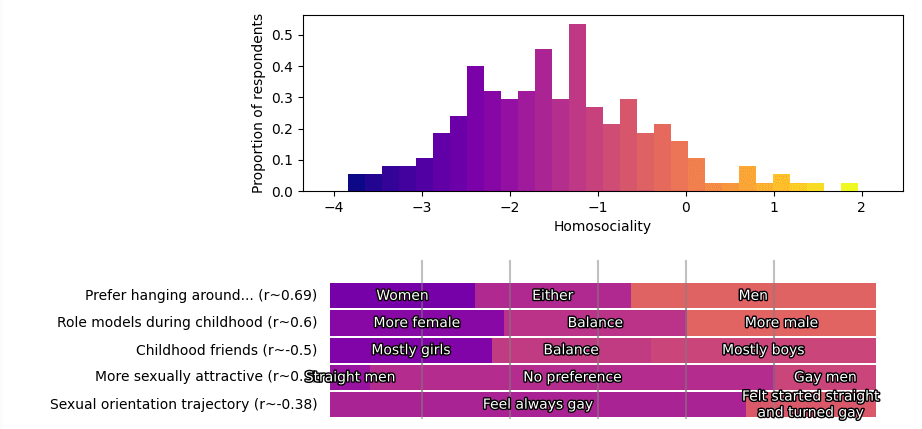
The strongest correlate of Gender Identity was Feminine Appearance. It's unclear to me what the direction of causality is here. There was also some connection for Gender Identity with the Neuroticism/Eccentricity/Sensitivity factor as well as with the Homosociality factor, which replicates some weak trends that were also observed in the final factor analysis of my study in straight men.
Unlike in straight men, gay gender progressivism didn't correlate with gender identity. Perhaps because among gay men, gender progressivism tags along with gay pride? So gender progressives' greater acceptance of gay men cancels out their greater acceptance of trans identity?
Extraversion consistently comes up in these surveys because it is related to gender role success among men, but it doesn't correlate much with the affective gender identity measure I've used. I guess because extraverted men might be equally successful as women, while introverted men would be equally unsuccessful? And probably also because the Neuroticism/Eccentricity/Sensitivity factor absorbed many of the items that were more related to gender identity.
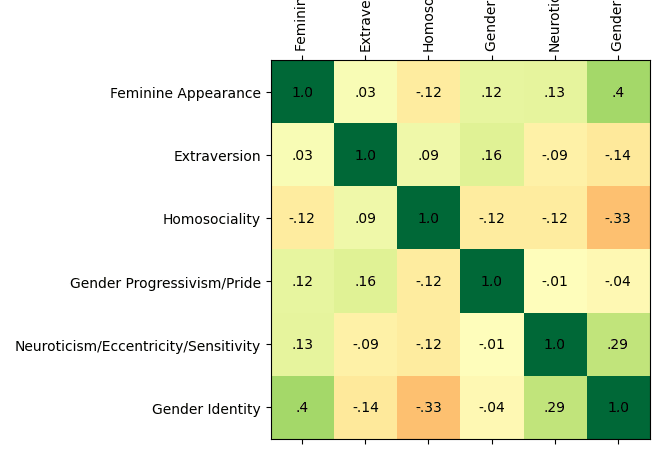
Measurement quality in gAyGP
Conventional wisdom is that gay men cannot be autogynephilic. In pop-Blanchardian circles, I've heard it asserted that any apparently gay men who claim to be so are actually meta-attracted (i.e. not gay, and just have sex with men because their autogynephilia makes them like to be admired as women). I've argued against this in the past, giving some evidence that gay men claiming autogynephilia are still actually gay.
Since autogynephilia is so strongly related to gender identity in straight men, it thus seems natural to also try to assess it when studying gender identity in gay men. I included many items in the survey for doing so.
To help validate the data and obtain more information, among the items I included this qualitative question:

This alerted me to a problem in the data for autogynephilia in gay men. Many of the gay men who scored high in autogynephilia left this item with "N/A", or explicitly stated that they had no autogynephilic sexuality. Probably the reason this happened so much is because autogynephilia is rarer in gay men than straight men, so the relative contribution from "noise" respondents was higher.
(I don't think the "N/A"s were just out of laziness or privacy concern, because that wouldn't explain why it was a bigger fraction of gay than straight responses.)
To solve this, I read through the responses to the qualitative question to separately code "true AGP" (when the respondents described a fantasy that was plausibly autogynephilic) vs "fake AGP" (when they did not). To test the quality of my AGP items, I then decided to correlate them with the scores for true or fake AGPs to see what they picked up most on. I had items from multiple different AGP scales, and they did not all perform equally well in ascertaining true or fake AGP:
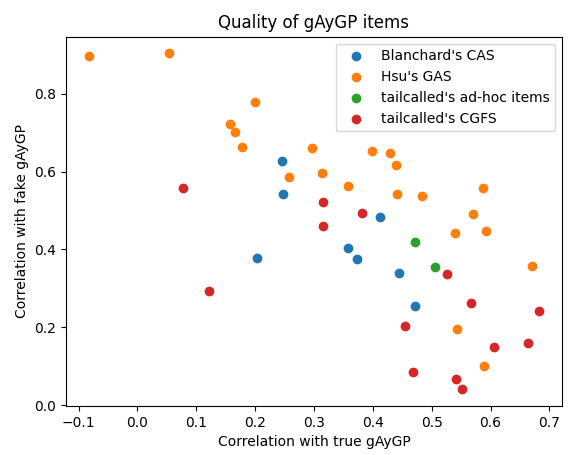
The best-performing scale was my own cross-gender fetishism scale (CGFS), which you can see here. It had been explicitly designed to have items that were as varied as possible while still being applicable to most AGPs, and I think that is what caused it to perform so well. That said, the qualitative item used was part of the CGFS, so it is conceivable that the proximity to the other items biased the apparent validity of the CGFS upwards.
The least valid scale was Kevin Hsu's General Autogynephilia Scale, and in particular the least valid item was the item "Picturing yourself getting my hair done at a lady's salon", presumably because it is not very erotic to most AGPs. Ray Blanchard's Core Autogynephilia Scale was of intermediate validity.
Due to the higher performance of my CGFS, I decided to score autogynephilia exclusively using those items, and throw away the data from the other scales. This lead to the following distribution of autogynephilia:
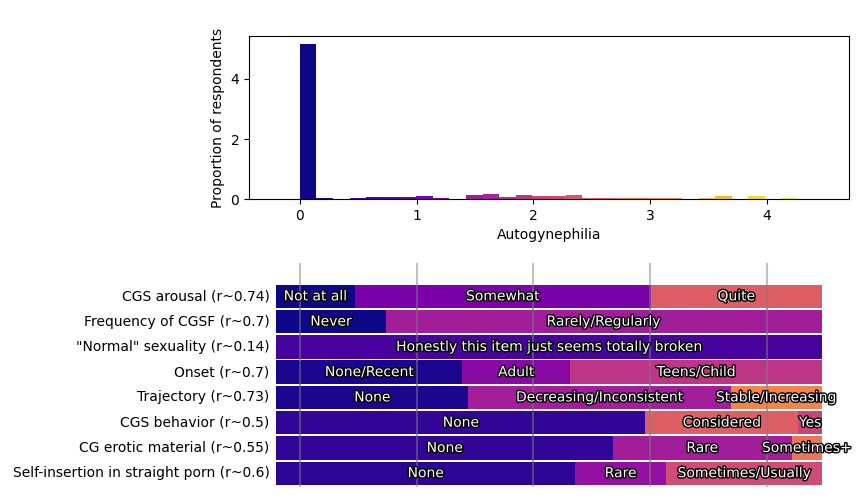
To give a better idea of what gAyGP is like, the sexual fantasies of the highest-scoring respondents are listed below:
- "A woman with multiple men"
- "A woman having sex with a group of attractive straight men"
- "I would love to be a woman who regularly fucks arabic men where sex is frowned upon"
- "I’m a woman in Germany and a nazi pushes me into a dark corner and puts his fingers in my cunt. Then he kisses me, not taking no for an answer. I can feel his gun and his cock. He tells me I’m hot. He rips my panties down and unbuckles his trousers. Then he fucks me. Then he slaps me and walks away. His friends cheer him."
- "How could I look after gender reassignment surgery"
- "The most erotic sexual fantasy I can think of following this would be being feminized through wearing something like a dress or skirt."
- "Being an attractive women e.g. blonde hair, large breasts, clean face and long blonde or black hair having sex with a masculine male. Also,being dominated by a masculine male as a hot woman."
- "I think the most erotic fantasy I have concerning cross-gender fetishism is where I am, for whatever reason, a woman, having sex with a straight man. I think the most significant part of that fantasy for me to the ability to have sex with a straight guy, but since I am a woman, there is no awkwardness and the straight guy is in his element, having sex with his usual partner. (And not knowing I'm anything different)"
- "Generally the aspects of it I find attractive don't involve any actual shift in gender, as in I would imagine myself remaining as a man, but taking on more feminine aspects. So for example, crossdressing without a distinct shift in gender identity."
- "Not solely a fantasy, but I find it hot for my husband to use "sissy" language at me during sex, and to make me wear women's underwear or stockings for his pleasure."
Because of the frequent references to "straight men", I thought it relevant to investigate whether gAyGP is caused by attraction to straight men. There didn't seem to be much correlation though:
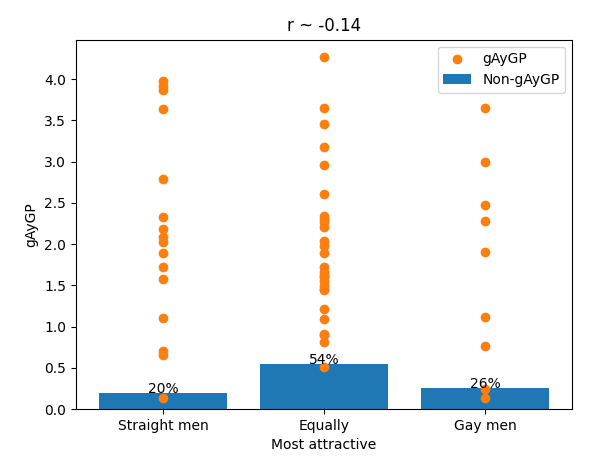
In case gAyGP was caused less by being attracted to straight men and more by receiving sexual attention from straight men (perhaps due to being feminine and attracting men who are attracted to feminized males), I also created a three-item scale measuring intercourse with straight men. The items were "Do straight men find you sexually attractive?", "Have you ever had sex with a straight man?" and "Do you ever try to flirt with straight men, or otherwise try to attract straight men?", and they were highly correlated with each other. The resulting scale scores weren't correlated with gAyGP either:
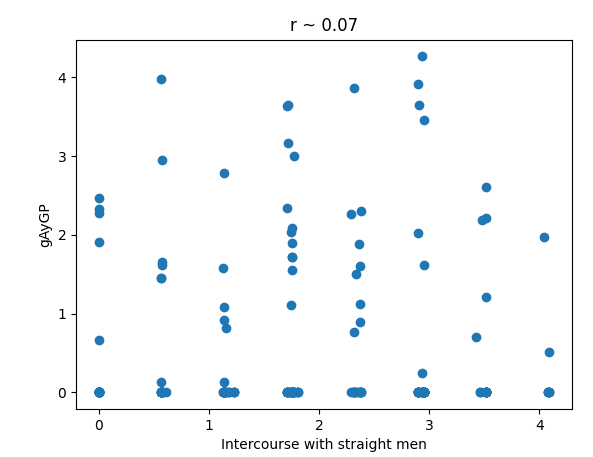
Strong gAyGPs might be feminine subby bottoms
Here's a correlation matrix with gAyGP and the different factors identified earlier:
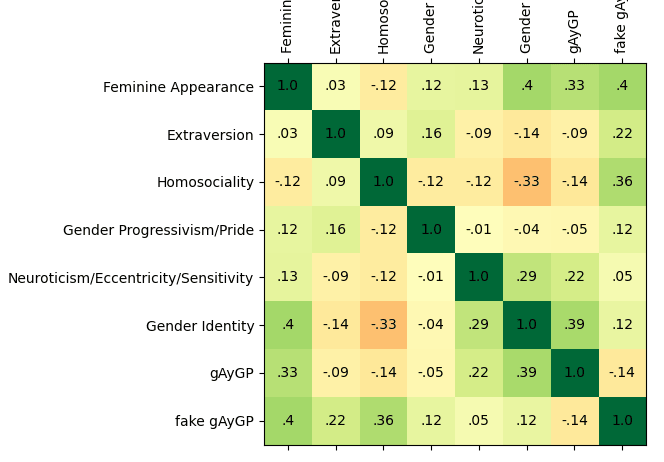
As expected, gAyGP was a strong correlate of Gender Identity.
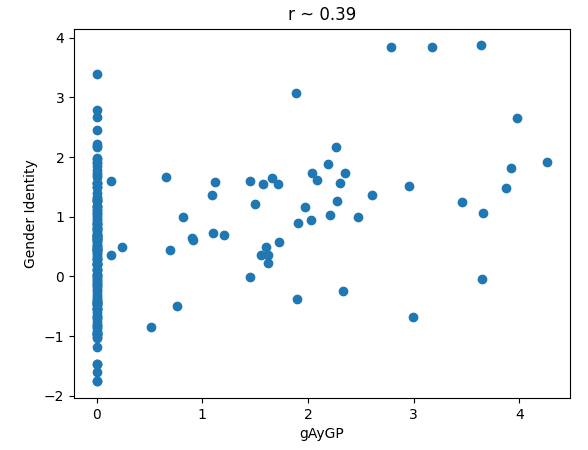
But there was also a connection to Feminine Appearance. This raises questions of causality - does gAyGP motivate pursuing feminine appearance and wanting to be a woman, or are there simply feminized men who thus want to be women, including sexually?
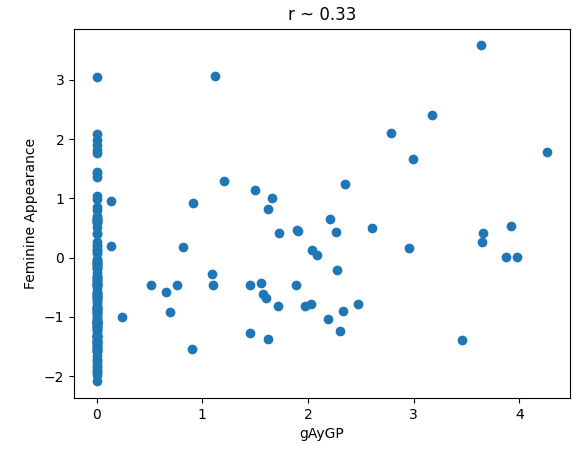
One avenue for investigating this would be if there is a "general factor of feminization" which causes other aspects of femininity that are less semantically/symbolically related to gender identity, yet which still correlate with Gender Identity due to their shared root in feminization. That is, while gAyGP could plausibly motivate wearing feminine clothing, it seems less likely that it would motivate working as a social worker. If these non-gender-identity-loaded feminine traits were also correlated with gAyGP, it would support the possibility of gAyGP being an artifact of feminization. I tried putting in some masculinity/femininity scales (Sociosexuality, Emotionality, MF-Occ, PSAI modified to be about recalled rather than current activities, OSRI), with ambiguous results:
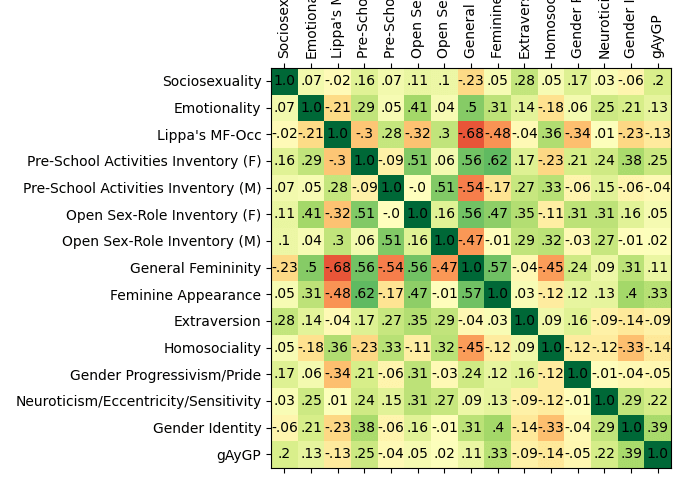
The strongest correlate of Feminine Appearance was recalled feminine childhood activities according to the PSAI-F. However, this probably had some conceptual overlap with gender identity due to the PSAI having items like "Pretend to be a princess" and "Dress up in girlish/frilly/feminine clothing".
The other scales had weak correlations with General Femininity and Gender Identity. MF-Occ had a correlation of -0.13 with gAyGP, which on the one hand is the size we would expect from a MF-Occ <- Femininity -> gAyGP relationship (0.33*-0.48=-0.16), but on the other hand it is right at the edge of statistical significance, so it is unclear how real it is.
The weakness of these results make me unable to have a clear conclusion on the direction of causality between gAyGP and femininity. So let's look at another topic, sexuality. The gay men who scored the highest on the gAyGP scale seemed to disproportionately be bottoms and sexually submissive:
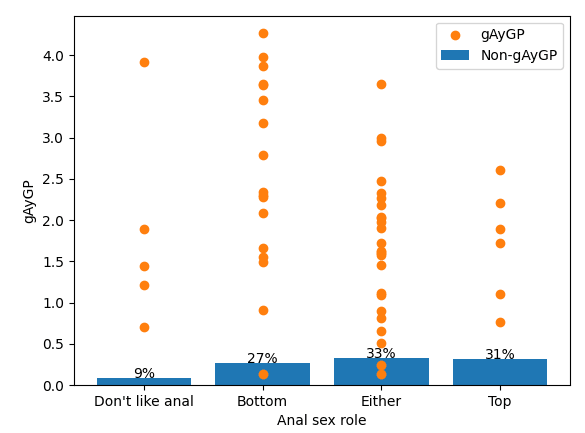
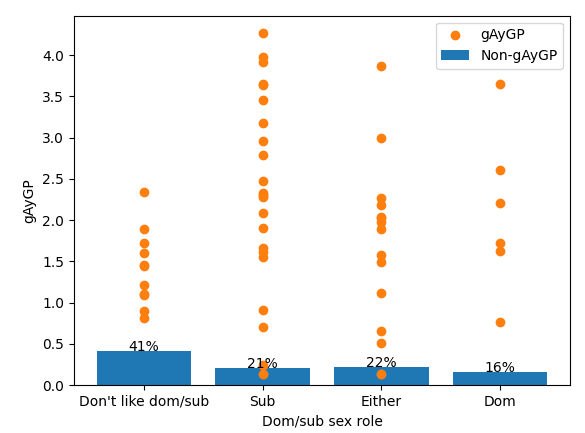
Straight autogynephiles are known to be gynandromorphophilic (GAMP), i.e. attracted to trans women. In retrospect I should have asked properly about this, but the only thing I asked about was about how arousing they would find various types of porn, one of which being masc men x trans women:
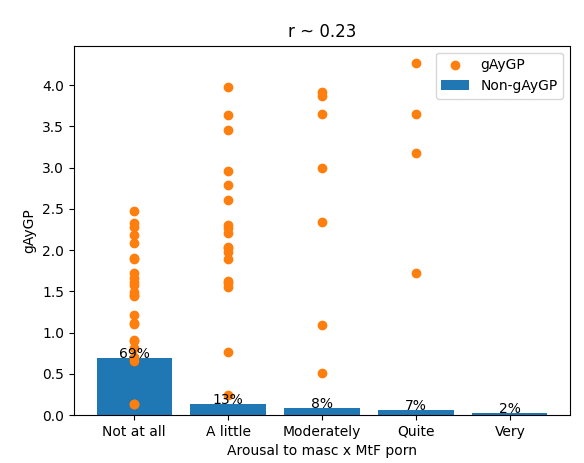
As mentioned earlier, some people claim that gAyGPs are not actually gay, and that this is revealed by their porn preferences. However, many in this sample of gAyGPs reported being aroused by masc male x masc male porn:
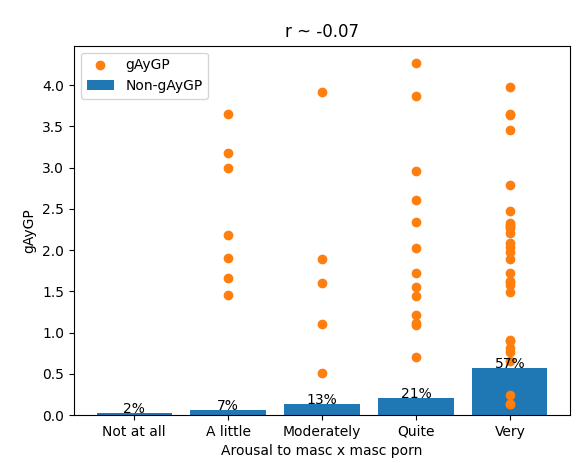
Conclusion
I'm not as happy with this survey as the previous one. For straight men, it seemed like we found two major motives underlying gender identity. Meanwhile here, "Feminine Appearance" seems like a correlate more so than a motive, and gAyGP turned out relatively ambiguous in its causal role.
Since performing this study, I also performed a similar study in women, where I found two separate factors of gender identity with seemingly separate motives. This makes me regret that I didn't study gender identity in a more multidimensional way for gay men.
Also, a lot of the findings for gAyGP are brushing up against sample size limitations, due to the low frequency of gAyGP. A future study should probably consider oversampling gAyGPs.
Still, I think this study is progress. My prior research into femininity had focused on straight men and "general factor of femininity" type considerations; getting reminded to focus on feminine appearance in gay men is probably relevant to future investigations. More generally, mapping out the factor structure of large sets of items is always neat. Furthermore, the way this study has concretized gAyGP seems good.